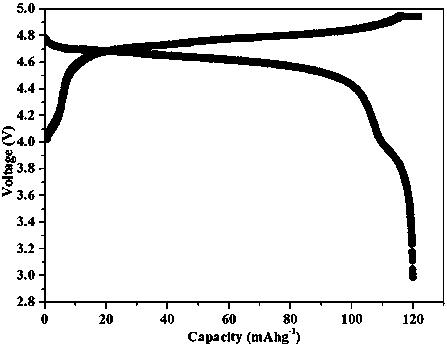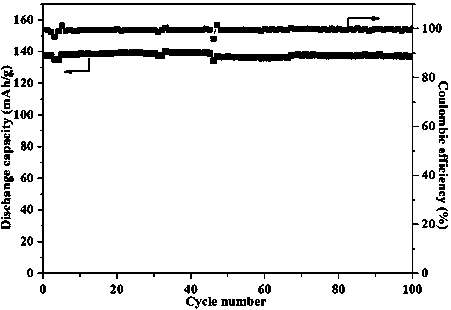Solid electrolyte containing polymer with main chain containing sulfur, solid secondary lithium battery formed by solid electrolyte as well as preparation method and application of solid electrolyte
A solid electrolyte and polymer technology, applied in the manufacture of electrolyte batteries, non-aqueous electrolyte batteries, secondary batteries, etc., can solve the problems of high electronic conductivity, increased risk of battery short circuit, and low mechanical properties.
- Summary
- Abstract
- Description
- Claims
- Application Information
AI Technical Summary
Problems solved by technology
Method used
Image
Examples
Embodiment 1
[0064] Take 1g of main chain sulfur-containing polymer (n=100, PSCO), 10g of N,N-dimethylacetamide was added to a 50ml reagent bottle, and stirred at room temperature for 6h to obtain a uniform PSCO main chain sulfur-containing polymer solution. Then, 0.1 g of lithium dioxalate borate was added to the above homogeneous solution, and stirred at room temperature for 24 hours to obtain a homogeneous mixed solution. The solution was evenly poured onto the non-woven cellulose membrane, and dried in a vacuum oven at 60°C for 24 hours to obtain a PSCO-C solid electrolyte.
Embodiment 2
[0066] Take 1g of main chain sulfur-containing polymer (n=65, PS), 10g of N,N-dimethylacetamide were added to a 50ml reagent bottle, and stirred at room temperature for 6h to obtain a homogeneous PS main chain sulfur-containing polymer solution. Then, 0.3 g of lithium trifluorooxalate sulfonylimide was added to the above homogeneous solution, and stirred at room temperature for 24 h to obtain a homogeneous mixed solution. The solution was uniformly poured onto the non-woven cellulose membrane, and dried in a vacuum oven at 60°C for 24 hours to obtain a PS-C solid electrolyte.
Embodiment 3
[0068] Take 2g main chain sulfur-containing polymer (n=120, PSEO), 18g of N,N-dimethylacetamide were added to a 250ml reagent bottle, and stirred at room temperature for 6h to obtain a homogeneous PSEO main chain sulfur-containing polymer solution. Then, 0.2 g of lithium perchlorate and 0.25 g of polyethylene oxide were added to the above uniform solution, and stirred at room temperature for 24 hours to obtain a uniform mixed solution. The solution was uniformly poured onto the PET non-woven film, and dried in a vacuum oven at 60°C for 24 hours to obtain a PSEO / PEO-PET solid electrolyte.
PUM
| Property | Measurement | Unit |
|---|---|---|
| thickness | aaaaa | aaaaa |
| mechanical strength | aaaaa | aaaaa |
| electrical conductivity | aaaaa | aaaaa |
Abstract
Description
Claims
Application Information
 Login to View More
Login to View More - R&D
- Intellectual Property
- Life Sciences
- Materials
- Tech Scout
- Unparalleled Data Quality
- Higher Quality Content
- 60% Fewer Hallucinations
Browse by: Latest US Patents, China's latest patents, Technical Efficacy Thesaurus, Application Domain, Technology Topic, Popular Technical Reports.
© 2025 PatSnap. All rights reserved.Legal|Privacy policy|Modern Slavery Act Transparency Statement|Sitemap|About US| Contact US: help@patsnap.com



